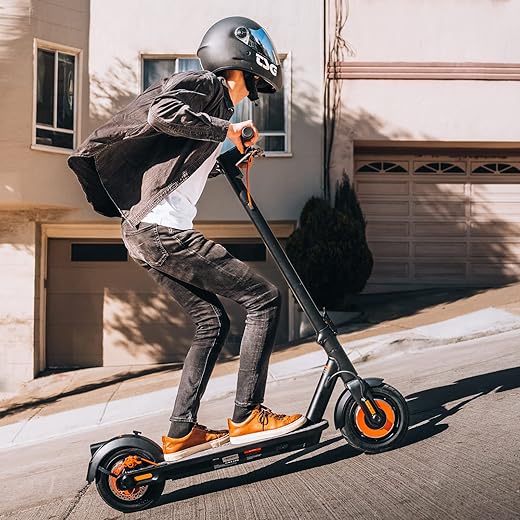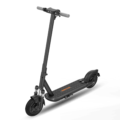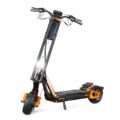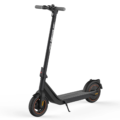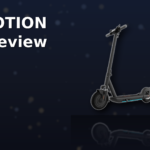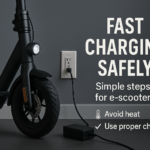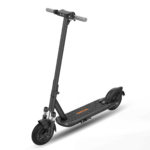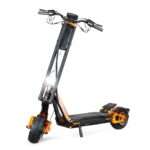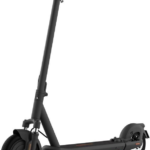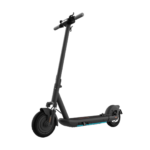- Home
- Scooters
- Electric Scooters
- INMOTION Climber
INMOTION Climber
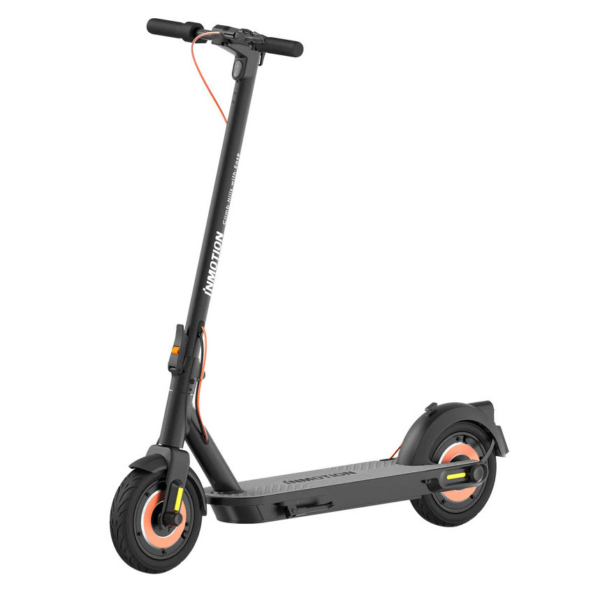


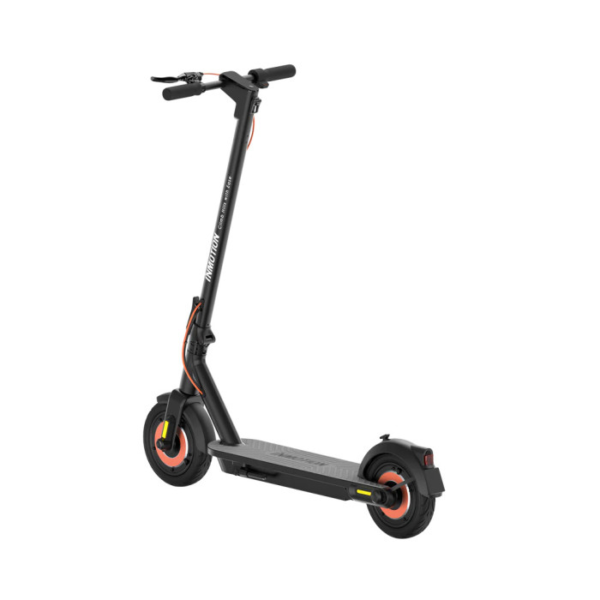
- Battery Range: 35 miles (56 km)
- Top Speed: 23.7 mph (38.1 km/h)
- Motor Power: 2 × 450 W
- Weight Capacity: 287 lb (130 kg)
- Charging Time: ~9 h
- Scooter Weight: 45.8 lb (20.8 kg)
PROS
- Dual 450 W motors with 750 W peak each
- 10″ pneumatic tires
- Rear disc + electronic braking
- IPX6 water resistance
- 287 lb (130 kg) max load
CONS
- Heavier than single-motor commuters
- No suspension
- Range modest versus larger packs
- Long charge time with stock charger
Key Takeaways
- The INMOTION Climber is a dual-motor scooter designed for urban commuting, weighing 20.8 kg and featuring a folding design.
- It offers three ride modes: Pedestrian (6 km/h), Dynamic (25 km/h), and Sport (38 km/h) for varied environments.
- With a 36-volt, 533 Wh battery, it provides a range of up to 56 km, depending on conditions and rider weight.
- The Climber features a mechanical disc brake in the front and rear electronic braking for enhanced safety and stopping power.
- Overall, it suits city commuters who need a compact, easy-to-carry scooter with solid performance on hills.
Table of contents
- What Is the INMOTION Climber?
- How the INMOTION Climber Works
- Key Specifications
- Design & Build Quality
- Performance Fundamentals
- Battery, Range & Efficiency
- Ride Quality & Comfort
- Braking & Safety Features
- Portability & Daily Usability
- Maintenance & Care
- Weather & Seasonal Considerations
- INMOTION Climber vs Alternatives
- Who the INMOTION Climber Is (and Isn’t) For
- FAQs
- Glossary
- Final Thoughts
The INMOTION Climber is a compact dual-motor scooter made for busy city life. It hits hard on hills, yet it stays light and easy to carry. The official specifications point to a 36-volt, 533 Wh pack and two 450 W hubs, which is a sweet spot for daily rides. City commuters, students, and train-plus-scooter folks will feel right at home. If you want a bigger deck and more range, check the INMOTION S1. If you’d rather go lighter for short hops, the INMOTION Air keeps things simple.
What Is the INMOTION Climber?
The INMOTION Climber is a 20.8 kg (45.8 lb) commuter with motors in both wheels. It folds fast, slides under a desk, and stays calm at neighborhood speeds. The deck leaves enough room to shift your stance. The 10-inch pneumatic tires cut street buzz better than most solid setups.
You get three modes with clear caps and feel. Pedestrian holds 6 km/h (3.7 mph) for crowded paths. Dynamic reaches 25 km/h (15.5 mph) for bike lanes. Sport climbs to 38 km/h (23.6 mph) for open stretches. The cockpit stays simple. A right thumb throttle controls speed. A left lever runs the front mechanical disc. The rear motor adds electronic braking to finish stops and recover a bit of energy.
How the INMOTION Climber Works
Two hub motors share the work at launch. They pull smoothly from a stop and keep traction on worn asphalt. Picture two people pushing a cart in step. Each motor is 450 W nominal, with short peaks near 750 W. So hill starts feel less stressful, and quick merges feel safer.
A compact controller manages current to both ends. It reads your throttle and the battery state, then smooths power so the scooter feels steady instead of jumpy. The battery sits inside the deck. Capacity is 36 V at 14.7 Ah, which equals 533 Wh. That gives a solid energy buffer for city miles. The stock charger outputs 42 V at 2 A. A full charge takes roughly nine hours from low. The system blends the front disc with rear electronic braking. Then the regen drag you feel as you release the throttle adds a soft first stage of slowing.
Key Specifications
| Block | Item | Value |
|---|---|---|
| General | Model | INMOTION Climber (LE1) |
| Rider height | 130–200 cm . 51.2–78.7 in | |
| Recommended age | 14–60 years | |
| Performance & Power | Motors | Dual hub . 450 W nominal each . ~750 W peak each |
| Max speed | 38 km/h . 23.6 mph | |
| Max slope | ~36% | |
| Battery, Charging & Electrical | Battery | 36 V . 14.7 Ah . 533 Wh |
| Charger | 42 V 2 A . ~9 h to full | |
| BMS protections | Over-charge . over-discharge . over-current . short circuit . over-temperature | |
| Build & Dimensions | Unfolded size | 1165 × 510 × 1195 mm . 45.9 × 20.1 × 47.0 in |
| Folded size | 1165 × 510 × 550 mm . 45.9 × 20.1 × 21.7 in | |
| Net weight | 20.8 kg . 45.8 lb | |
| Max payload | 130 kg . 286.6 lb | |
| Tires | 10-inch pneumatic . road-biased tread | |
| Safety & Control | Brakes | Front mechanical disc . rear electronic brake with regen |
| IP rating | IP56 | |
| Lighting | Headlight and taillight . front and rear reflectors | |
| Features & Extras | Ride modes | Pedestrian 6 km/h . Dynamic 25 km/h . Sport 38 km/h |
| Cruise control | Yes | |
| App | INMOTION app for activation and stats | |
| Warranty & Compliance | Compliance | CE . RoHS . UN 38.3 . FCC |
| Warranty | Varies by region and seller |
Those specifications place the Climber in the compact dual-motor class with strong hill manners and a short learning curve.
Design & Build Quality
The frame looks tidy and purposeful. The clamp hardware sits out of the way, so sleeves and bags do not snag. The stem locks with a lever and a threaded ring. You can snug the ring with the basic tools if play shows up. The hook at the top of the stem clips to the rear fender when folded. Then one-hand carries feel more secure on stairs.
The deck is long enough for a shoulder-width stance. Grip tape covers the useful surface without slick gaps. The charging port sits on the deck side under a firm rubber cap. Cable routing stays neat. The main harness runs inside the stem, which lowers scuff risk. Fit and finish are solid for this weight class. Panel lines are tight, and the plastics around the head unit and tail feel sturdy.
The cockpit keeps things simple. The centered display reads clean in daylight. The right thumb throttle has a short, light throw. The left lever lands within reach for medium hands. Riders with smaller hands can slide the clamp a few millimeters inward. That minor tweak shortens the sweep and improves comfort.
Performance Fundamentals
Launch feels brisk yet controlled. Dual motors help the scooter step off the line without a heavy kick start. Sport mode gives the strongest pull for short gaps. Dynamic smooths the curve for bike paths and shared spaces. Pedestrian caps speed at a walking pace for plazas and crowded sidewalks.
Cruising stability is a highlight. The low deck and 10-inch air tires keep the scooter planted over seams and joints. The chassis resists wobble if you keep a soft bend in your knees. The stem shows a little flex under load, which is normal for a folder. So the scooter tracks straight through paint lines and minor ripples.
Hills are where the Climber earns its name. On 7–10% grades, it holds pace better than most single-motor 36 V commuters. Start from a slow roll if you can. Keep your weight centered. Then the controller trims current on long climbs to protect the system. You still feel steady thrust rather than surges, which helps you pick clean lines around cracks and drain covers.
Battery, Range & Efficiency
The pack stores 533 Wh. That number comes from 36 V times 14.7 Ah. The practical meaning is simple. You have enough juice for a typical city day if you avoid constant sprints and keep tire pressure in range.
Rated range lands near 56 km (34.8 mi) under set test conditions. Real results swing with weight, wind, hills, and temperature. A 165 lb rider on flat ground at 20–25 km/h with 3.5 bar (50 psi) will see better numbers. A heavier rider on cold, hilly routes will see fewer. So plan a buffer. Aim for routes that use 60–80% of the pack. Then you keep spare bars for detours and headwinds.
Charging is straightforward. Open the cap. Plug in the 42 V 2 A charger. Wait for green. A full charge takes about nine hours from low. Let the pack cool for a few minutes after hard rides before you plug in. Close the cap firmly when you finish. The BMS covers over-charge, over-discharge, short circuit, over-current, and high temperature. That mix supports long-term pack health if you avoid deep drains and heat.
Small habits that stretch miles
- Keep pressure between 2.5 and 3.5 bar. Lower for comfort. Higher for range.
- Cruise in Dynamic on long flats. Save Sport for gaps and hills.
- Hold a steady throttle hand. So the controller spends less time in wasteful peaks.
- Plug in at one or two bars. Then you avoid deep discharges that stress the pack.
Ride Quality & Comfort
Pneumatic tires do most of the comfort work here. They smooth small chatter from patches and seams, and they grip wet paint better than most solid tires. Pressure matters a lot. Run near 3.5 bar for range and sharp steering. Drop toward 2.5 bar for rough pavement and brick. Check valves weekly. A compact pump with a gauge pays off fast.
There is no suspension. The frame and deck foam handle the rest. Slow for expansion joints, sunken utility covers, and potholes. The deck length supports a stable stance. Turn your front foot a bit. Place your rear foot across the deck with the heel near the fender. Keep your knees soft so the scooter flows over ripples instead of fighting them.
The cockpit helps comfort, too. The grips feel firm without being harsh. The throttle throw is short, so your thumb stays fresh on longer runs. The brake lever has a predictable ramp. That consistency builds trust. Then you can trim speed in traffic without big inputs.
Braking & Safety Features
The front wheel uses a mechanical disc with strong bite at half pull. The rear motor adds electronic braking as you roll off the throttle. That regen drag gives a gentle first stage of slowing before the disc does the heavy lifting. Practice in an empty lot. Start with light pulls at 10 km/h. Add pressure until you learn the bite point and your stopping distance. Keep your feet low. Shift a bit of weight rearward. The scooter stays straight as speed drops.
Lighting is practical and bright enough for city use. The headlight throws a clean beam. The tail light helps riders and drivers behind you judge distance. Front and rear reflectors improve side visibility at night. The IP56 rating signals strong dust and splash resistance. Still, treat water as a risk, not a feature. Puddles can hide sharp edges. Standing water can attack bearings and connectors over time. Ride to a dry spot when the weather turns.
Portability & Daily Usability
Portability is a core strength. The Climber weighs 20.8 kg, which is manageable for short carries. Use two hands for long stairs. The fold is quick. Press the safety button. Pull the lever. Lower the stem until the hook meets the rear catch. The folded size is 1165 × 510 × 550 mm. That footprint fits small trunks and narrow hallway corners without hogging space.
The display wakes fast. Speed and mode read at a glance. Buttons respond to short presses for most functions. The app handles activation and basic ride stats. Lock the scooter indoors when you can. A sturdy U-lock or chain through a solid anchor beats a cable every time.
Maintenance & Care
A small routine keeps things tight and quiet.
Before every ride
- Check tire pressure. Aim for 2.5–3.5 bar.
- Spin both wheels. Listen for rubs or scraping.
- Squeeze the brake. Look for a firm bite and a centered rotor.
- Hold the stem and rock it. If you feel play, snug the folding ring and hardware.
Weekly
- Wipe the deck and charging area. Keep the port clean and capped.
- Inspect pads for glazing or uneven wear.
- Check exposed fasteners with a light touch. Do not crank on them.
Monthly
- Check the app for firmware updates.
- Inspect tires for cuts and embedded grit.
- Clean the rotor with a bike-safe cleaner if you hear squeal.
Charging and storage
Charge on a stable, dry surface. Let the pack cool a few minutes after hard use. Keep the scooter within the stated temperature window while charging. If you pause riding for weeks, park the battery near 60–80% and top it monthly.
Weather & Seasonal Considerations
Water, heat, and cold change range and grip. Rain lowers traction. So slow down, keep inputs smooth, and avoid painted lines and metal covers. Cold trims range. Plan for fewer miles per bar near freezing. Heat raises pressures and ages rubber faster. Park in shade when you can. Wipe the scooter dry after wet streets. Then open the charge port only when everything is dry.
Leaves in fall are slick. Brake early on leaf-covered patches and stay upright through turns. Winter salt attacks metal parts. Wipe the deck, rotor, and hardware with a damp cloth after salty rides. Dry the scooter before storage.
INMOTION Climber vs Alternatives
Against single-motor 36 V commuters, the Climber launches harder from lights and holds speed better on hills. It stops with more authority thanks to the front disc plus rear electronic braking. Weight stays in the mid-40s in pounds, which works for walk-ups and train platforms.
Bigger performance scooters with 52–60 V packs bring higher top speeds and more range. They also weigh more, take more space, and feel like overkill for many city trips. The Climber trades peak pace for an easy fold and daily simplicity. If you carry your ride often, that trade makes sense.
Trail-ready models with suspension and knobby tires eat dirt and roots. The Climber is a city tool first. It rolls best on pavement and hardpack. Smooth lines, steady speed, and smart braking bring out its best.
Who the INMOTION Climber Is (and Isn’t) For
Best for
- Daily commuters who climb short, steep streets.
- Students who want one scooter for campus and errands.
- Multi-modal riders who mix trains and buses with a scooter.
- Apartment dwellers who need a fast fold and a small footprint.
Not ideal for
- Riders who want long-travel suspension and off-road tires.
- All-day touring above 40–50 km on a single charge.
- Very tall riders who want a much wider deck or higher bars.
So the INMOTION Climber fits urban life. It does that job with a quick fold, predictable handling, and low daily fuss.
FAQs
How fast does the INMOTION Climber go?
Sport mode reaches 38 km/h, about 24 mph. The scooter feels stable at that pace on smooth pavement.
How far can I ride on one charge?
The rated figure is about 56 km. Real range depends on rider weight, hills, wind, stops, and tire pressure. So plan a little buffer.
Does it handle hills well?
Yes. Dual motors help on steep starts. The listed slope figure is around 36% under set test rules.
What brake setup does it use?
A front mechanical disc does the main work. The rear motor adds electronic braking as you roll off the throttle. The blend feels natural after a short practice session.
Is it water-resistant?
The rating is IP56 for dust and splashes. You should still avoid riding in rain or through standing water. Treat the rating like insurance, not a green light.
What charger does it include, and how long does charging take?
The stock charger outputs 42 V at 2 A. A full charge takes roughly nine hours from low.
Where can I find an INMOTION Climber overview in one place?
Right here. This INMOTION Climber overview collects design, power, range, care, and daily use in one read.
Glossary
Ah (amp-hours)
Battery capacity. A higher number means more stored charge.
Wh (watt-hours)
Total energy. Voltage times amp-hours.
Voltage (V)
Electrical pressure that pushes current through the motors.
Controller
The small computer that meters current to the motors and keeps power smooth.
Dual motor
Two hub motors. One front and one rear. Better traction and launch.
Regen
Regenerative braking. The motor slows the wheel and feeds a little energy back.
BMS
Battery Management System. It protects the pack against common faults.
IP rating
Ingress Protection code. IP56 means strong dust protection and resistance to powerful water jets.
Stem flex
Side-to-side movement you can feel at the handlebar under load. A little is normal on folders.
Pneumatic tire
An air-filled tire that cushions bumps and grips well.
Pedestrian, Dynamic, Sport
Ride modes that cap speed and change throttle feel.
Peak power
Short bursts above nominal output. Handy for starts and hills.
Disc brake
A caliper squeezes a rotor on the wheel to slow you down.
Thumb throttle
A lever you press with your thumb to control speed.
Final Thoughts
The INMOTION Climber focuses on the daily ride. It brings dual-motor punch, clean manners, and easy care to a compact frame that fits tight spaces. It is not built for trails or high-speed touring. It is built for city miles that start at your door and end at your desk. Those specifications and on-road habits make it a smart pick if you value balance over extremes.
Specifications
General
| Model The Model specifies the exact version or name of the scooter. It helps identify its unique design, features, and specifications within the manufacturer’s product line. Knowing the model makes it easier to compare options, find compatible accessories, or look up support information. | Climber |
| Brand The Brand identifies the manufacturer or company that designs and produces the scooter. A trusted brand is a sign of quality, reliability, and good customer support. Well-known brands often have higher standards for safety, performance, and after-sales service, giving you more confidence in your purchase. | INMOTION |
| Release Date The Release Date indicates when the scooter model was officially launched on the market. This helps you know how current the design, technology, and features are. A newer release date often means updated components, improved performance, and the latest safety or smart features. | 18 November 2025 |
| Recommended Age Recommended Age indicates the minimum age range that the scooter is designed for, based on safety, size, and ease of use. Following the recommended age helps ensure that riders can handle the scooter’s speed, weight, and controls comfortably and safely. Always check local laws and use protective gear, especially for younger riders. | +16 |
Performance & Power
| Motor Power (Wattage) What it means: The motor power, measured in watts (W), shows how strong the scooter’s electric motor is. Why it matters: Higher wattage usually means better acceleration, more torque, and improved performance on hills or rough terrain. For example, a 250W motor is good for flat city roads and light riders, while a 500W or 1000W motor provides more power for faster speeds or climbing steep inclines. | Dual hub motors 2 × 450 W (750 W ×2 peak) |
| Top Speed The Top Speed indicates the maximum speed that the scooter can reach under optimal conditions. It’s usually measured on level ground with a fully charged battery and an average rider weight. A higher top speed allows you to travel longer distances faster, but always ensure you ride within legal speed limits and your personal comfort zone for safety. | 23.7 mph (38.1 km/h) |
| Battery Capacity Battery Capacity refers to the total amount of energy the scooter’s battery can store, usually measured in ampere-hours (Ah) or watt-hours (Wh). A higher battery capacity means you can ride longer distances on a single charge, reducing the need for frequent recharging. Keep in mind that actual range can vary depending on rider weight, terrain, speed, and weather conditions. | 36 V 14.7 Ah (533 Wh) |
| Estimated Range per Charge The Estimated Range per Charge indicates the average distance the scooter can travel on a single full battery charge. This range is calculated under optimal conditions, such as flat terrain, moderate speed, and average rider weight. Real-world range may vary depending on riding style, terrain, weather, and load. A longer range means fewer recharges and greater freedom for longer trips. | 35 miles (56 km) |
| Hill Climb Ability Hill Climb Ability describes the maximum incline or slope that the scooter can handle while maintaining stable performance. It’s typically expressed as a percentage or in degrees. A higher hill climb rating means the scooter can tackle steeper hills without losing too much speed or power. Actual climbing performance may vary based on rider weight, battery charge, and terrain conditions. | 36% |
| Drive System The Drive System refers to how power from the motor is delivered to the wheels. Electric scooters typically use either a hub motor (directly integrated into the wheel) or a chain/belt drive system. A high-quality drive system ensures smooth acceleration, efficient power transfer, and low maintenance. The choice of drive system affects performance, noise level, and overall ride experience. | Dual hub (2WD) |
Charging & Electrical
| Charging Time Charging Time indicates how long it takes to fully recharge the scooter’s battery from empty to 100% using the standard charger provided. Faster charging means less downtime and more time on the road. Actual charging time may vary slightly depending on battery capacity, charger output, and environmental conditions. | Approx. 9 hours |
| Battery Type Battery Type refers to the specific technology used in the scooter’s battery, which affects performance, lifespan, weight, and charging time. Most modern electric scooters use high-quality lithium-ion (Li-ion) batteries because they offer a good balance of energy density, durability, and low maintenance. A reliable battery type ensures consistent power delivery and longer riding ranges. | 21700 lithium-ion pack with Smart BMS |
| Removable Battery A Removable Battery means the battery pack can be easily detached from the scooter for convenient charging and replacement. This feature allows you to charge the battery separately, swap it with a spare for extended range, or securely store it indoors in extreme weather. Removable batteries add flexibility and make it easier to keep your scooter powered up wherever you are. | Non-removable internal battery (fixed pack) |
| Regenerative Braking Regenerative Braking is an energy-saving feature that converts some of the energy normally lost during braking back into battery power. When you slow down or brake, the motor works in reverse to generate electricity, which helps extend the scooter’s range and improves overall efficiency. This system also reduces wear on traditional brake components, leading to lower maintenance over time. | Yes (via electronic brake) |
| Lighting Lighting refers to the built-in front and rear lights that enhance visibility and safety when riding in low-light conditions or at night. Good lighting helps you see the road ahead and ensures that other road users can see you. Many scooters include LED headlights, taillights, and sometimes brake lights or side reflectors for added safety and compliance with local traffic regulations. | LED headlight, rear LED/brake, reflectors |
Build & Dimensions
| Scooter Weight Scooter Weight refers to the total weight of the scooter when fully assembled, including the battery. This affects how easy it is to carry, lift, and store the scooter when not in use. A lighter scooter is more portable and convenient for commuting, especially if you need to carry it upstairs or onto public transport. Keep in mind that a sturdy frame and quality components may add to the weight but also contribute to better durability and ride stability. | 45.8 lb (20.8 kg) |
| Maximum Rider Weight Maximum Rider Weight indicates the highest rider weight that the scooter is designed to safely support while maintaining optimal performance and stability. Staying within this limit helps ensure reliable acceleration, braking, and climbing ability, and it protects the frame, suspension, and motor from excessive strain. Exceeding the recommended limit may reduce performance and increase wear on components. | 287 lb (130 kg) |
| Deck Size Deck Size refers to the dimensions of the scooter’s standing platform. A wider and longer deck provides more foot space, allowing you to stand comfortably and adjust your stance while riding. A well-sized deck improves balance and stability, especially on longer rides or at higher speeds. Compact decks, on the other hand, help keep the scooter lightweight and portable. | Sturdy frame for hill climbing |
| Handlebar Height Handlebar Height refers to the distance from the deck to the handlebars, which affects your riding posture and comfort. An appropriate handlebar height helps you maintain good balance, reduces strain on your back and arms, and makes steering more comfortable. Some scooters have adjustable handlebars to fit riders of different heights, while others have a fixed height for a streamlined design. | Fixed |
| Folding Mechanism The Folding Mechanism describes how easily and securely the scooter can be folded for carrying and storage. A well-designed folding system lets you quickly collapse the scooter into a compact size, making it convenient to transport on public transit, store under a desk, or fit into a car trunk. Look for sturdy latches and safety locks to ensure the scooter stays firmly in place when folded or unfolded. | Quick-fold latch |
| Dimensions Folded Dimensions indicate the size of the scooter when it’s fully folded. This measurement shows how much space the scooter will take up when stored or carried, making it easier to check if it will fit in your car trunk, under a desk, or in a closet. Compact folded dimensions are ideal for commuters who need to bring their scooter on public transport or store it in tight spaces. | Unfolded 45.9 × 20.0 × 47.0 in (1166 × 508 × 1194 mm). Folded 45.9 × 20.0 × 21.7 in (1166 × 508 × 551 mm) |
| Material Material refers to the primary construction materials used for the scooter’s frame and key components. High-quality materials like aircraft-grade aluminum, reinforced steel, or durable composites provide strength, stability, and a lighter overall weight. A sturdy material ensures the scooter can handle daily wear and tear while maintaining safety and performance. | Aluminum alloy |
Safety & Control
| Brake Type(s) Brake Type(s) describe the braking systems the scooter uses to help you slow down or stop safely. Common brake types include mechanical brakes (like drum or disc brakes), electronic brakes, and foot brakes. Many scooters combine multiple braking systems for added safety and shorter stopping distances. The type and quality of brakes affect your control, especially when riding at higher speeds or on slopes. | Rear disc + electronic braking |
| Suspension Suspension refers to the system that absorbs shocks and vibrations while riding, providing a smoother and more comfortable ride over uneven or rough surfaces. Scooters may have front suspension, rear suspension, or dual suspension for better shock absorption and stability. Good suspension helps reduce rider fatigue and improves control, especially when riding on bumpy roads or off-road paths. | None |
| Tire Type Tire Type refers to the kind of tires the scooter uses, which directly affects ride comfort, traction, and maintenance. Common types include solid (airless) tires, pneumatic (air-filled) tires, or hybrid options. Pneumatic tires offer better shock absorption and a smoother ride on rough surfaces, while solid tires are puncture-proof and require less upkeep. The right tire type helps ensure safe handling and a comfortable ride in different conditions. | 10″ pneumatic street tires |
| Tire Size Tire Size indicates the diameter and width of the scooter’s tires, which affect ride comfort, stability, and how well the scooter handles different terrains. Larger tires generally offer better shock absorption and a smoother ride over bumps and rough surfaces, while smaller tires keep the scooter lighter and more portable. Choosing the right tire size helps ensure a balance between agility and comfort. | 10-inch |
| Kickstand The Kickstand is a built-in stand that allows you to park your scooter upright when it’s not in use. A sturdy kickstand keeps the scooter stable and prevents it from tipping over, protecting it from scratches and damage. It also makes storing and accessing your scooter more convenient, whether you’re at home, work, or on the go. | Side kickstand |
| Water Resistance Rating Water Resistance Rating indicates how well the scooter is protected against water and moisture, usually shown as an IP (Ingress Protection) rating. This rating helps you understand whether the scooter can handle light rain, splashes, or wet roads without damage. While most scooters are not fully waterproof, a good water resistance rating adds peace of mind when riding in changing weather conditions. Always avoid deep puddles or submerging the scooter to protect its electrical components. | IPX6 |
Features & Extras
| Display/Console The Display (or Console) shows important real-time information about your ride, helping you monitor your scooter’s status at a glance. Typical displays show speed, battery level, distance traveled, and riding mode. Some models also include additional features like Bluetooth connectivity, app integration, or backlighting for better visibility at night. A clear and easy-to-read display enhances safety and convenience on every trip. | LED display with speed, battery, modes |
| Ride Modes Ride Modes refer to the different speed and power settings you can choose to match your riding style or road conditions. Common modes include eco for maximum range and energy efficiency, standard for everyday balance, and sport or turbo for higher speed and stronger acceleration. Switching between ride modes allows you to customize performance, conserve battery, and ride safely in various environments. | Eco/Drive/Sport (3 modes) |
| Smart App Connectivity Smart App Connectivity lets you pair your scooter with a dedicated mobile app via Bluetooth. Using the app, you can monitor real-time ride stats like speed, battery level, and range, adjust settings such as ride modes or cruise control, lock the scooter for added security, and sometimes receive firmware updates. This feature adds convenience and allows you to personalize your riding experience right from your smartphone. | INMOTION App: lock, stats, settings |
| Anti-Theft System The Anti-Theft System helps protect your scooter from unauthorized use or theft. This feature can include built-in alarms, electronic motor locks, GPS tracking, or remote locking through a mobile app. A good anti-theft system provides peace of mind when parking your scooter in public spaces, adding an extra layer of security to safeguard your investment. | App lock |
| Cruise Control Cruise Control allows you to maintain a steady speed without continuously holding the throttle. This feature makes longer rides more comfortable by reducing hand fatigue and providing a smoother, more relaxed riding experience — especially on flat, open roads or bike lanes. For safety, cruise control can usually be easily activated or deactivated while riding. | Yes (cruise control) |
| Accessories Included Accessories Included lists the additional items that come with the scooter to enhance your riding experience and convenience. Common accessories may include a charger, kickstand, bell, lights, phone holder, or carrying strap. These extras add value by making your scooter safer, easier to use, and ready to ride straight out of the box. | Scooter, charger (42 V 2 A), tools, manual |
Warranty & Compliance
| Warranty Period The Warranty Period indicates how long the manufacturer guarantees the scooter against defects in materials and workmanship under normal use. A good warranty provides peace of mind, showing the brand’s confidence in its product quality. Always check what parts are covered, such as the frame, battery, and motor, and follow the maintenance guidelines to keep your warranty valid. | 12 months (region-dependent) |
| Certifications Certifications confirm that the scooter meets specific safety, quality, and environmental standards set by recognized organizations or regulatory bodies. Common certifications may include CE, RoHS, UL, or other local compliance marks, depending on your region. These certifications ensure that the scooter is manufactured to high standards and is safe and legal to use in your country. | Local micromobility compliance |



